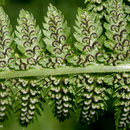en
names in breadcrumbs


Athyrium (lady-fern) is a genus of about 180 species of terrestrial ferns, with a cosmopolitan distribution. It is placed in the family Athyriaceae, in the order Polypodiales.[1][2] Its genus name is from Greek a- ('without') and Latinized Greek thyreos ('shield'), describing its inconspicuous indusium (sorus' covering).[3] The common name "lady fern" refers in particular to the common lady fern, Athyrium filix-femina.[4]
Athyrium species are used as food plants by the larvae of some Lepidoptera species including the small angle shades and Sthenopis auratus.
There are about 180, including:
 19th-century illustration of A. filix-femina
19th-century illustration of A. filix-femina Athyrium (lady-fern) is a genus of about 180 species of terrestrial ferns, with a cosmopolitan distribution. It is placed in the family Athyriaceae, in the order Polypodiales. Its genus name is from Greek a- ('without') and Latinized Greek thyreos ('shield'), describing its inconspicuous indusium (sorus' covering). The common name "lady fern" refers in particular to the common lady fern, Athyrium filix-femina.
Athyrium species are used as food plants by the larvae of some Lepidoptera species including the small angle shades and Sthenopis auratus.